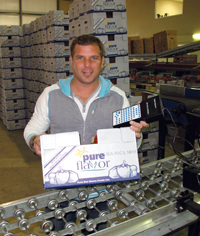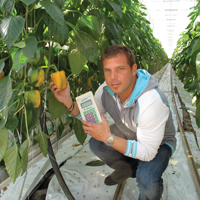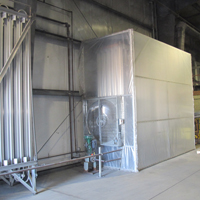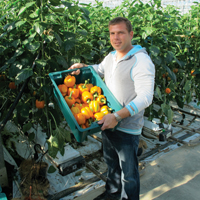
Every vegetable harvested at Cedar Beach Acres, located just off Lake Erie near Kingsville, Ontario, has a story to tell.
Every vegetable harvested at Cedar Beach Acres, located just off Lake Erie near Kingsville, Ontario, has a story to tell.
Just check the packing box bar code, and you’ll know every input that went into growing it, and who picked it and when.
 |
|
| Rob Mastronardi with a carton displaying the bar code.
|
It’s all part of a computerized program Cedar Beach developed during its involvement with the Traceability Project in 2007-08, all coordinated by the Ontario Ministry of Agriculture, Food and Rural Affairs. A number of farm sectors were involved.
Cedar Beach was a 2010 regional winner in the Premier’s Award for Agri-Food Innovation Excellence program for its traceability project.
Similar traceability systems have since been adopted throughout the Ontario greenhouse sector.
The system was largely developed in house by Cedar Beach manager Rob Mastronardi, and food safety coordinator Amy Lee Butcher. It took six months to develop.
ALL CROP INPUTS AND HARVESTING INFORMATION IS EASILY ACCESSED
■ Cedar Beach can trace all the inputs that went into growing its vegetables, including the fertilizers, the beneficials used, and the cardboard boxes used to ship, among numerous other inputs. The worker who picked the vegetable, when it was picked, and the row from which it was picked, is also recorded, and the information is immediately retrievable.
“Everything is traced,” says Mastronardi, “from the seedling to the store shelf. We know everything about that product.”
Such traceability is a major food safety tool for the industry, but it has other benefits.
“It’s really helped with our inventory control,” says Butcher. “There’s no excess inventory on hand. It’s all coordinated in real time with our marketer (Pure Hothouse Foods Inc.). What we have here is inputted into the computer and they know exactly what we have. It helps them fill orders.”
PIECEWORK PAY INCENTIVES MEANS MORE MONEY FOR WORKERS
■ Employees have embraced the concept, though at first they were a little skeptical. Cedar Beach is working towards more piecework, and the data loggers the employees use to input their work have made it much easier to record their work. “They’re working less hours and making more money, so they’re happy,” says Mastronardi.
 |
|
| Cedar Beach employees log in all crop activities |
It’s also made his job as manager and grower a lot easier. “I don’t have to be in the greenhouse watching the workers as often as I used to.” Key production information is now more readily available to him.
Getting the call from OMAFRA to participate in the Traceability pilot project is not surprising; Cedar Beach has been an industry innovator since its launch by Rob and his dad, Bob, in 2004.
The company has grown its vegetables under glass since day one, deviating from the Ontario industry standard of double poly. (In recent years, other growers have put up glass greenhouses, though they’re still in the minority.)
CHOOSING GLASS EARLY ON IN A PREDOMINATELY POLY WORLD
■ Why the glass in a predominately double poly world? “It’s much better for light in the winter,” says Mastronardi. With the use of a fixed curtain in the winter – which is perforated to allow moisture out of the crop – and a retractable curtain system, it’s more energy efficient than comparable double poly systems, he says. They also use screens in the summer to keep things cool and shaded.
For years, they have heated with alternative fuels, including wood waste. Currently, they’re burning oat hulls, and with excellent results. The supply is consistent and steady, and it burns well.
They’re also among growers working within an energy cooperative coordinated by CF Industrial of Leamington to use backup generators to supply electricity to the grid during short-term peak energy demands.

|
|
| Cedar Beach is using cool air captured from its liquid CO2 unit to cool its packing house and irrigation room.
|
They’re hoping to add a co-gen plant in the future, but the province has not yet decided on adding more co-gen supply from greenhouses. “It would be great to capture the heat and CO2 and produce electricity for the grid.”
A wind turbine is also being considered. This would be used to power supplemental lighting for extended season production of cucumbers and eggplants.
Cedar Beach also stands out with its broad product mix within its six hectares. Initially, they specialized in beefsteak tomatoes, but then decided “we didn’t want to put all our eggs in one basket.”
HELPING MARKETER FILL NICHE MARKET ORDERS
■ Its marketer, Pure Hothouse, has a number of niche markets, including specialty tomatoes, mini-cucumbers and baby eggplants, and Cedar Beach is among suppliers filling those orders.
In addition to niche products, Cedar Beach also has large-scale pepper production.
There are partition walls to isolate climate zones required for each crop. The irrigation system is also set up to serve individual crop zones.
They’ve also developed a process to capture cool air from their liquid CO2 system. This cold air is cooling the packing facility and irrigation room. “It’s cut cooling costs by 25 per cent in the packing house, and there’s a 5°C drop in temperatures in the irrigation room.” Cooler irrigation water in the summer is good for the crops enduring the heat.
 |
|
| Peppers are one of the major crops at Cedar Beach.
|
Rob has travelled to other regions to see new technologies, including Mexico, British Columbia, the U.S. and the Netherlands. And Cedar Beach welcomes its share of visitors each year as well.
INCENTIVE PROGRAMS HELP WITH INNOVATION
■ “We’re always looking for ways to improve efficiencies and cut costs,” says Mastronardi. “There are some good incentive programs available from both the provincial and federal governments. It’s nice when you can be rewarded for innovation.”
Rob is among the fourth generation of his family in the greenhouse industry. The hours can be long, but the rewards are many. “It’s never the same-old, same-old,” he quips. “You really have to be a jack of all trades.”
He appreciates the work of his staff, many of whom have worked at Cedar Beach for several years, including most of the offshore workers. It’s that collective experience that makes everything run so much smoother. “You have to surround yourself with great employees, and we have them here.” ■
Print this page